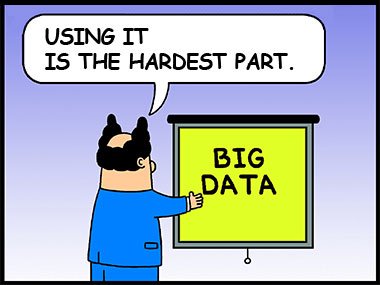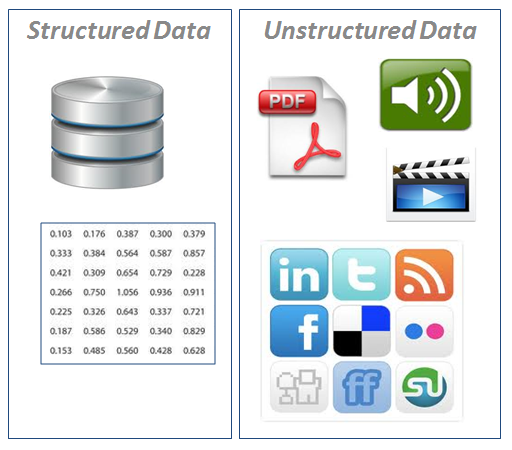Since the market introduced this term we’ve tried to make a distinction between data and ‘more’ 
data. In my opinion all data is ‘big data.’ That the challenge for IT departments is how to ‘quickly’ turn these new sources of data into ‘value’ for the business. In this blog post I’ll explain where we are with big data – illustrate the issues and propose a solution.
Backdrop
Within Life Sciences (pharmaceuticals and medical devices) ‘big data’ has been in place for quite some time. Most companies have had to address the challenges of managing data for instance:
- Financial data – this would include your typical data for operating your company. There are additional complexities from a sales and rebate perspective along with cross border/country tax issues for products.
- Supply Chain data – includes your typical sales and operations data plus the traceability of packaged pharmaceuticals or individual devices.
- Clinical trials data – generating data that needs to be translated into information for product approval as well as storing data for adverse events analysis.
Government regulations influence how companies manage data. Most firms are required to maintain patient data for the life of the user. Managing data is also part of any legal defense in the event of product failures in the field, and the random audit from the FDA and other regulatory bodies.
Influences
If Life Sciences companies maintain their data we are dealing with large repositories of data. What are influencing IT departments are the changes in today’s markets, for instance:
- Mergers and Acquisitions – most companies are prepared for this both from a due diligence prior to the acquisition. In most cases there is a common set of financial and supply chain information that is shared until an IT decision is made to absorb, or let stand, the IT landscape of the acquired company. There are a few firms that still operate in a mixed IT environment. So this can be a challenge without the right strategy for reporting and analytics.
- Mobile devices – we’ve already been made aware of the growing use of smartphones and tablets. Besides the security aspects of these devices. Data needs to be made available at various levels of the organization. This is a topic that most IT departments are struggling with, and an area that requires a strategy with feedback from your users.
- Digital Marketing or Business Insights – we should be aware that ‘social media’ is having a huge impact on Marketing. The advent of these new tools and data sources (Twitter, Facebook, Pinterest, etc.) poses several data questions:
- How do we analyze and treat these new sources of customer/patient feedback?
- With more and more doctors using tablets how do we get our product messages to them, and can we measure the impact on our market share?
- How do I plan for this additional explosion of data because we still have the existing ‘structured’ data, and now we are adding new sources of ‘unstructured’ data?
- Marketing and Business folks are asking for this information for further analysis? IT has to decide on the tools and methods to perform this analysis.
So are you effectively using ‘bigdata,’ and if not what plans do you have to support the business and your company’s growth targets?
Reporting Strategy and Elastic Analytics
If you are in this situation there is a need to prepare your ‘reporting strategy.’ Typically this is a 6 to 8 week exercise to identify the business needs and match this against your current IT landscape and solutions. I often recommend this exercise because if you have this strategy in place you can leverage this output for funding needs, new tools, etc., as well as a discussion with the business. Focus on immediate pain points and demonstrate ‘quick wins’ will go a long way to ensuring that IT is still a strategic influence within your organizations.
Yet even if you have you’re strategy in place you may need to move faster to help the business. At Capgemini we have introduced a solution called ‘elastic analytics.’ The link below is a video which provides a high level summary for this offering.
Capgemini Elastic Analytics video
Elastic Analytics helps IT with the following:
- If the deployment of your reporting strategy is a lengthy process then elastic analytics can provide you with ‘quick wins’ that demonstrate the ‘art of the possible’ when it comes to reporting and analytics. All you need to do is provide the data and we will process this into information served up in a variety of outputs (from a dashboard to a screen on a Smartphone or tablet).
- Let’s say you want to ‘test’ out different analytics tools using your data. Using elastic analytics there is no need for you to invest in and take time out for product demos. This landscape includes most of the leading products on the market. This allows you the freedom to test your data on multiple products.
- Maybe there is no in-house expertise when it comes to the science of converting data into meaningful information. Within this offering we have up 250 data scientists that can help you correlate your data into relevant business information.
In summary, if all data is big date then are you using this ‘effectively?’ There are various reasons for companies to look into changing their approach to reporting and analytics. What I’ve explained is available today, and I hope this helps you decide how best to approach your problem.
I am open to your feedback or suggestions, so tell me what you think?
Thanks,
Jim


